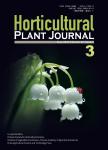Genome-wide characterization of MATE family members in Cucumis melo *** their expression profiles in response to abiotic and biotic stress
作者机构:College of Horticulture Science and EngineeringShandong Agricultural UniversityTai’anShandong 271018China State Key Laboratory of Crop BiologyShandong Agricultural UniversityTai’anShandong 271018China Institute of VegetablesShangqiu Academy of Agriculture and Forestry SciencesShangqiuHenan 476002China
出 版 物:《Horticultural Plant Journal》 (园艺学报(英文版))
年 卷 期:2022年第8卷第4期
页 面:474-488页
核心收录:
学科分类:0710[理学-生物学] 09[农学] 0902[农学-园艺学] 090202[农学-蔬菜学]
基 金:supported by National Key Research and Development Program of China (Grant No. 2018YFD1000) Shandong Vegetable Research System (Grant No. SDAIT-05–05) Major Agricultural Application Technology Innovation Project of Shandong Province (2018) The Key Research and Development Program of Shandong and Chongqing Cooperation (Grant No. 2020LYXZ001)
主 题:Melon MATE Orthologous relationship GO term Expression Stress
摘 要:The multidrug and toxic compound extrusion(MATE) family plays pivotal roles in the detoxification process in plants, while no information has been provided for this gene family in melon(Cucumis melo L.) thus far, limiting our understanding of its functions in melon acclimation to stressful environments. In this study, a total of 39 MATEs(CmMATE1–CmMATE39) were observed in the melon genome;these were unevenly distributed in all chromosomes, with the most on Chromosome 1. Based on their orthologous relationship with those from Arabidopsis, rice, and sorghum, melon MATEs were clustered into three subfamilies of Clades Ⅰ, Ⅱ, and Ⅲ, wherein 23, 9, and 7 members were included, *** exon number was observed in CmMATEs, and the most were harbored by CmMATE8. Gene ontology(GO) term and cis-regulatory element(CRE) analyses pointed to the potential roles of CmMATEs in both the regulation of melon development and acclimation to various abiotic and biotic stressors. The RNA-seq and qRT-PCR(quantitative real-time PCR) results demonstrated that under normal growth conditions, CmMATEs were expressed in a tissue-and development-specific manner, while their abundance apparently varied in a stress-dependent manner when melon plants were exposed to unfavorable environmental conditions. Altogether, these observations could expand our knowledge about the plant MATE family and benefit functional genomics analysis for CmMATEs in the future.



